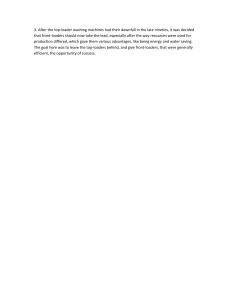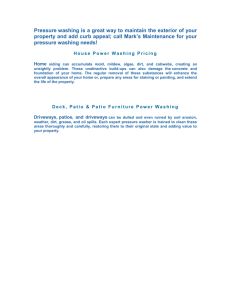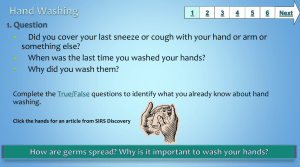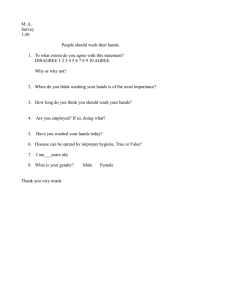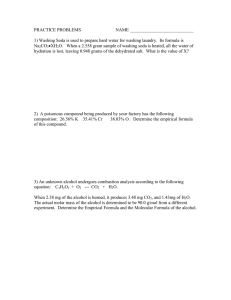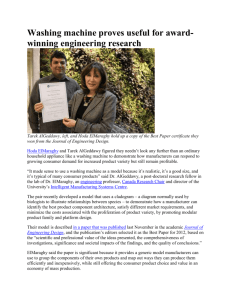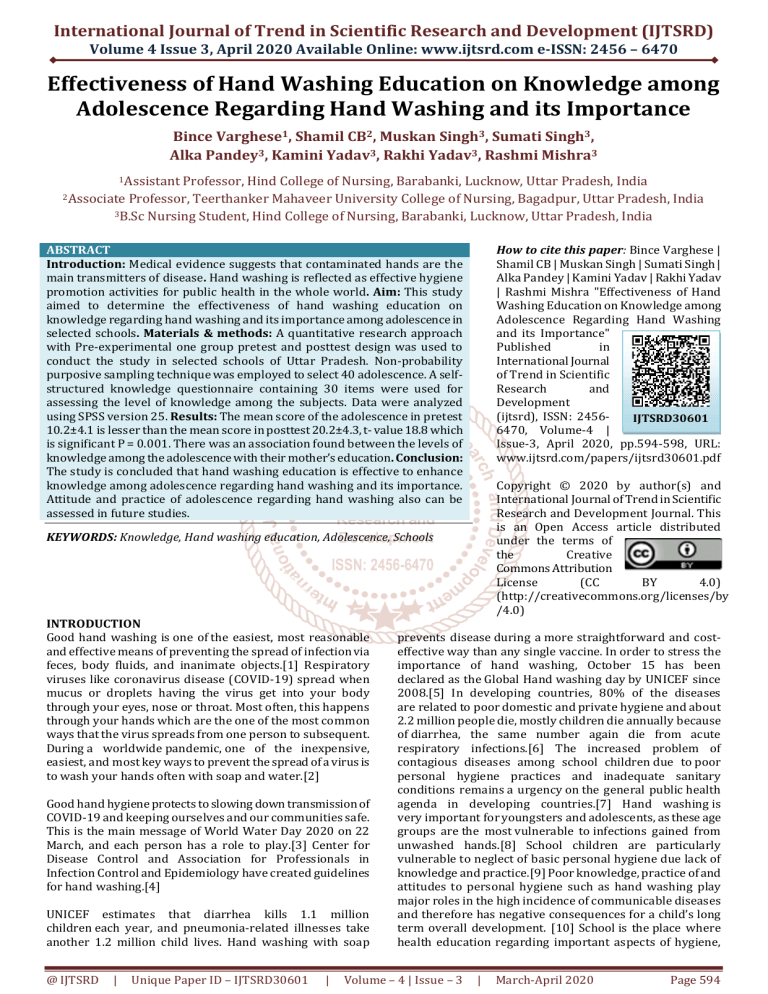
International Journal of Trend in Scientific Research and Development (IJTSRD)
Volume 4 Issue 3, April 2020 Available Online: www.ijtsrd.com e-ISSN: 2456 – 6470
Effectiveness of Hand Washing Education on Knowledge among
Adolescence Regarding Hand Washing and its Importance
Bince Varghese1, Shamil CB2, Muskan Singh3, Sumati Singh3,
Alka Pandey3, Kamini Yadav3, Rakhi Yadav3, Rashmi Mishra3
1Assistant
Professor, Hind College of Nursing, Barabanki, Lucknow, Uttar Pradesh, India
Professor, Teerthanker Mahaveer University College of Nursing, Bagadpur, Uttar Pradesh, India
3B.Sc Nursing Student, Hind College of Nursing, Barabanki, Lucknow, Uttar Pradesh, India
2Associate
ABSTRACT
Introduction: Medical evidence suggests that contaminated hands are the
main transmitters of disease. Hand washing is reflected as effective hygiene
promotion activities for public health in the whole world. Aim: This study
aimed to determine the effectiveness of hand washing education on
knowledge regarding hand washing and its importance among adolescence in
selected schools. Materials & methods: A quantitative research approach
with Pre-experimental one group pretest and posttest design was used to
conduct the study in selected schools of Uttar Pradesh. Non-probability
purposive sampling technique was employed to select 40 adolescence. A selfstructured knowledge questionnaire containing 30 items were used for
assessing the level of knowledge among the subjects. Data were analyzed
using SPSS version 25. Results: The mean score of the adolescence in pretest
10.2±4.1 is lesser than the mean score in posttest 20.2±4.3, t- value 18.8 which
is significant P = 0.001. There was an association found between the levels of
knowledge among the adolescence with their mother’s education. Conclusion:
The study is concluded that hand washing education is effective to enhance
knowledge among adolescence regarding hand washing and its importance.
Attitude and practice of adolescence regarding hand washing also can be
assessed in future studies.
How to cite this paper: Bince Varghese |
Shamil CB | Muskan Singh | Sumati Singh |
Alka Pandey | Kamini Yadav | Rakhi Yadav
| Rashmi Mishra "Effectiveness of Hand
Washing Education on Knowledge among
Adolescence Regarding Hand Washing
and its Importance"
Published
in
International Journal
of Trend in Scientific
Research
and
Development
(ijtsrd), ISSN: 2456IJTSRD30601
6470, Volume-4 |
Issue-3, April 2020, pp.594-598, URL:
www.ijtsrd.com/papers/ijtsrd30601.pdf
Copyright © 2020 by author(s) and
International Journal of Trend in Scientific
Research and Development Journal. This
is an Open Access article distributed
under the terms of
the
Creative
Commons Attribution
License
(CC
BY
4.0)
(http://creativecommons.org/licenses/by
/4.0)
KEYWORDS: Knowledge, Hand washing education, Adolescence, Schools
INTRODUCTION
Good hand washing is one of the easiest, most reasonable
and effective means of preventing the spread of infection via
feces, body fluids, and inanimate objects.[1] Respiratory
viruses like coronavirus disease (COVID-19) spread when
mucus or droplets having the virus get into your body
through your eyes, nose or throat. Most often, this happens
through your hands which are the one of the most common
ways that the virus spreads from one person to subsequent.
During a worldwide pandemic, one of the inexpensive,
easiest, and most key ways to prevent the spread of a virus is
to wash your hands often with soap and water.[2]
Good hand hygiene protects to slowing down transmission of
COVID-19 and keeping ourselves and our communities safe.
This is the main message of World Water Day 2020 on 22
March, and each person has a role to play.[3] Center for
Disease Control and Association for Professionals in
Infection Control and Epidemiology have created guidelines
for hand washing.[4]
UNICEF estimates that diarrhea kills 1.1 million
children each year, and pneumonia-related illnesses take
another 1.2 million child lives. Hand washing with soap
@ IJTSRD
|
Unique Paper ID – IJTSRD30601
|
prevents disease during a more straightforward and costeffective way than any single vaccine. In order to stress the
importance of hand washing, October 15 has been
declared as the Global Hand washing day by UNICEF since
2008.[5] In developing countries, 80% of the diseases
are related to poor domestic and private hygiene and about
2.2 million people die, mostly children die annually because
of diarrhea, the same number again die from acute
respiratory infections.[6] The increased problem of
contagious diseases among school children due to poor
personal hygiene practices and inadequate sanitary
conditions remains a urgency on the general public health
agenda in developing countries.[7] Hand washing is
very important for youngsters and adolescents, as these age
groups are the most vulnerable to infections gained from
unwashed hands.[8] School children are particularly
vulnerable to neglect of basic personal hygiene due lack of
knowledge and practice.[9] Poor knowledge, practice of and
attitudes to personal hygiene such as hand washing play
major roles in the high incidence of communicable diseases
and therefore has negative consequences for a child’s long
term overall development. [10] School is the place where
health education regarding important aspects of hygiene,
Volume – 4 | Issue – 3
|
March-April 2020
Page 594
International Journal of Trend in Scientific Research and Development (IJTSRD) @ www.ijtsrd.com eISSN: 2456-6470
environment and sanitation, also as social customs is being
imparted.[11]
Hence the researchers felt to conduct an experimental study
on knowledge regarding the importance of hand washing
among adolescence studying at schools. Objectives of this
study were determine the effectiveness of hand washing
education on knowledge regarding hand washing and its
importance among adolescence in selected schools in Uttar
Pradesh and to find the association of various factors with
the level of knowledge.
MATERIALS AND METHODS
A quantitative research approach with pre-experimental one
group pretest and posttest design was used to conduct the
study in selected schools of Uttar Pradesh. Non-probability
purposive sampling technique was adapted to select 40
adolescence selected from Ram Ashray Memorial Montessori
School from Uttar Pradesh. A self-structured knowledge
questionnaire was used to assess knowledge among
adolescence regarding hand washing and its importance.
Ethical and Administrative permission was taken from
authorizes in concerned areas. The consent form was
prepared for the study participant regarding their
willingness to participate in the research study. Inclusion
criteria: Adolescence aged 13-18 years, available during the
study period and willing to participate. Exclusion criteria:
Adolescence not present during the data collection
The research tool for data collection consists of two sections:
Section 1:- Demographic tool
It consists of age, gender, education, area of living, type of
family, fathers education, mothers education, monthly family
income and source of previous information are the
demographic variables.
Section 2:- Self-structured knowledge questionnaire
It consists of 30 items for assessing knowledge among
adolescence regarding hand washing and its importance.
Every item was of multiple choice types with one correct
answer carrying 1 mark remaining options 0 marks. The
total maximum score was 30 and the minimum score 0. The
score were arbitrarily graded as 0-10 inadequate knowledge,
11-20 moderate knowledge and 21-30 adequate knowledge.
Content validity of the tool was determined by experts in the
field of Community medicine and Nursing. The reliability of
the knowledge questionnaires was tested by using spearman
brown split half method and score was found to be r = 0.79.
The tool was prepared in English and Hindi to facilitate
better comprehension. Interventional module, Hand washing
education was prepared based on the review of literature
which consists of areas such as introduction, definition,
indications, benefits, steps, procedures and its importance.
Pre-test was followed by the administration of hand washing
educational module (1 hour per day) for the next 5
consecutive days. After one week of intervention, a post-test
was conducted by using the same questionnaire, data
collected was tabulated and analyzed with the help of
descriptive and inferential statistics. SPSS 25 (Statistical
Package for the Social Sciences, India) was used for
Statistical analysis and P = 0.05 was considered as the level
of significance.
RESULTS
The major findings of the study were as follows:
Table 1: Frequency and percentage distribution of demographic variables of subjects (n=40)
Demographic Profile
Frequency (%)
Age (years)
13-14
16 (40%)
15-16
14 (35%)
17-18
10 (25%)
Gender
Male
27 (67.5%)
Female
13 (32.5%)
Educational background (Stream)
High school
21 (52.5%)
Intermediate
19 (47.5%)
Area of living
Rural
24 (60%)
Urban
11 (27.5%)
Extended
5 (12.5%)
Type of family
Joint family
26 (65%)
Nuclear family
14 (35%)
Fathers education
Illiterate
9 (22.5%)
Primary
14 (35%)
Secondary
12 (30%)
Graduation & above
5 (12.5%)
Mothers education
Illiterate
20 (50%)
Primary
12 (30%)
Secondary
5 (12.5%)
Graduation & above
3 (7.5%)
@ IJTSRD
|
Unique Paper ID – IJTSRD30601
|
Volume – 4 | Issue – 3
|
March-April 2020
Page 595
International Journal of Trend in Scientific Research and Development (IJTSRD) @ www.ijtsrd.com eISSN: 2456-6470
Monthly family income (in Rupees)
< 15,000
> 15,001
Source of previous information
No information
Family members & Friends
Teachers
Mass media
Medical persons
24 (60%)
16 (40%)
15 (37.5%)
8 (20%)
5 (12.5%)
7 (17.5%)
5 (12.5%)
The table 1 displays that frequency and percentage distribution of demographic variables, the majority of the adolescence 40 %
were in the age group of 13 to 14, 67.5% were male, 52.5% were from high school, 60% were from rural area, 65% belonged to
joint family, majority 35% of respondents father had primary education in compare to 50% illiterate mothers, 60% were
having less than 15000 rupees family monthly income and the majority 37.5 % of adolescence did not get any previous source
of information.
Fig-1: Frequency and percentage distribution of knowledge level
Fig-1: shows that frequency and percentage distribution of overall gradation of knowledge level among adolescence regarding
hand washing and its importance, in the pre-test majority 62.5% had inadequate, 35% moderate and 2.5% adequate
Knowledge wherein post-test, the majority 60% had adequate Knowledge, remaining 40% moderate and none of them had
inadequate knowledge.
Table 2: Comparison of Knowledge score between Pretest and Posttest
Stress Score N Mean SD t- value df
P
Pre-total
40 10.2 4.1
18.8
39 0.001**
Post-total
40 20.2 4.3
**Significant (p<0.01)
The table 2 indicates that Comparison of pre-test and post-test knowledge score among the adolescence by using paired t-test,
the overall mean score in pre-test 10.2±4.1 was lesser than the post-test mean score 20.2±4.3 and the obtained t- value 18.8
which was significant P = 0.001. It is inferred that there is a significant difference in pretest and posttest knowledge among
adolescence. So the hand washing education is effective to enhance knowledge among adolescence regarding hand washing and
its importance.
Table 3: Association between pretest knowledge level with their demographic variables
Demographic Profile
≤ Median > Median
X2
df
P
Age (years)
13-14
8
8
15-16
8
6
1
2 0.6
17-18
7
3
Gender
Male
14
13
0.5
1 0.48
Female
9
4
Educational background (Stream)
High school
11
10
0.14 1 0.71
Intermediate
12
7
@ IJTSRD
|
Unique Paper ID – IJTSRD30601
|
Volume – 4 | Issue – 3
|
March-April 2020
Page 596
International Journal of Trend in Scientific Research and Development (IJTSRD) @ www.ijtsrd.com eISSN: 2456-6470
Area of living
Rural
14
10
Urban
5
6
Extended
4
1
Type of family
Joint family
15
11
Nuclear family
8
6
Fathers education
Illiterate
7
2
Primary
7
7
Secondary
7
5
Graduation & above
2
3
Mothers education
Illiterate
15
5
Primary
7
5
Secondary
1
4
Graduation & above
0
3
Monthly family income (in Rupees)
< 15,000
15
9
> 15,001
8
8
Source of previous information
No information
10
5
Family members & Friends
5
3
Teachers
3
2
Mass media
3
4
Medical persons
2
3
*Significant (p<0.05)
1.8
2
0.41
0
1
1
2.6
3
0.46
9.4
3
0.02*
0.21
1
0.65
1.8
4
0.76
Table 3 illustrates that Chi-square value in pretest knowledge score with the selected demographic value like respondents
mothers education (9.4) was significant (p= 0.02) and other variables like age (1), gender (0.5), educational background (0.14),
area of living (1.8), type of family (0), fathers education (2.6), family income (0.21) and previous source of information (1.8)
were not significant(p>0.05). Thus it can be concluded that there is an association between knowledge score with the mothers’
education of the adolescents.
DISCUSSION
The present study found that interventional program hand
washing education is effective to enhance knowledge among
adolescence about hand washing and its importance. These
results were supported by Garg A et al which displays there
were a significant enhancement in the knowledge regarding
hand-washing and frequency of hand-washing practices
after the intervention.[12] Guo N et al revealed that the
intervention of intensive education on hand hygiene
commendably improved personal hygiene among both
children and parents.[13] Lehotsky A et al found that
contemporary health education programs which including
four-hour and eight-hour pieces of training was effective on
increasing the knowledge about hand hygiene and technique
of hand washing in primary school-age children.[14] Md.
Abdur Razzak et al revealed that nutrition education
increased the hand washing practising behavior of the
adolescents and the tendency to use hygienic materials for
hand washing. [15]
Other studies by Yalçin SS et all noticed that adolescents
have limited knowledge about indications of hand-washing
and some problems unfavorably influenced handwashing.[16] Dobe et al conducted a cross-sectional study to
assess the prevalence of good hand-washing practice (GHP)
among adolescents which concluded that the prevalence of
adolescent GHP was 32.1% (95% CI = 27.1, 37.1).[17]
Tamilarasi R et al directed a study to assess the knowledge
and practice of hand washing among school-going
adolescents in Chennai, shows that only 24.9% were
@ IJTSRD
|
Unique Paper ID – IJTSRD30601
|
practising adequate hand washing even though 85.6% of had
adequate knowledge which concluded that the students have
a significant level of hand washing knowledge but effective
measures and long term inspiring activities should be taken
to improve their hand washing behavior.[18]
The present study found an association between the levels of
knowledge among the adolescence with their mother’s
educational status. In contrary, Ajay Kumar et al study
concluded that female students had more knowledge level
than male students.[19]
IMPLICATIONS AND RECOMMENDATION
Nurse educator could use these hand washing education
techniques to enhance knowledge among adolescence
regarding hand washing and its importance. Nurse
administrators can organize workshops or continuous
nursing education programs to update the knowledge of
community health nurses regarding the importance of hand
washing and which helps to prevent many diseases. A similar
study can be replicated on a large scale and for a longer
period for more reliability and efficacy. Attitude and practice
of adolescence regarding hand washing also can be assessed
in future studies.
CONCLUSION:
The study is concluded that hand washing education is
effective to enhance knowledge among adolescence
regarding hand washing and its importance. The overall
findings of the study showed that there is a significant
Volume – 4 | Issue – 3
|
March-April 2020
Page 597
International Journal of Trend in Scientific Research and Development (IJTSRD) @ www.ijtsrd.com eISSN: 2456-6470
association found between the levels of knowledge among
the adolescence with their mother’s education. The study is
limited to school going adolescence in selected schools in
Uttar Pradesh, India.
ACKNOWLEDGMENT
Authors genuinely acknowledge the adolescence students
who participated in the study and the school teacher and
authorities who permitted and supported this study. Authors
also acknowledge our colleagues, friends who helped in
conducting this study.
Financial support and sponsorship
Nil
[9] Vivas A, Gelaye B, Aboset N, Kumie A, Berhane Y,
Williams MA. Knowledge, Attitudes, and Practices
(KAP) of Hygiene among School Children in Angolela,
Ethiopia. J Prev Med Hyg. 2010; 51:73–79.
[10] Sarkar M. Personal hygiene among primary school
children living in a slum of Kolkata, India. Journal of
Preventive Medicine and Hygiene 2013; 54:153-158.
[11] Dongre AR, Deshmukh PR, Boratne AV, Thaware P,
Garg BS. An approach to hygiene education among
rural Indian school going children. Online J Health
Allied Sci. 2007; 6:2.
[12] Garg A, Taneja DK, Badhan SK, Ingle GK. Impact of a
school-based hand washing promotion program on
knowledge and hand washing behavior of girl students
in a middle school of Delhi. Indian J Public Health
2013;57:109-12
Conflicts of interest
There are no conflicts of interest
REFERENCE
[1] Center for Disease Control and Prevention (2009)
Department of Human and Services.
[2] Everything you need to know about washing your
hands to protect against coronavirus (COVID-19) |
UNICEF [Internet]. [cited 2020 Mar 28]. Available from:
https://www.unicef.org/coronavirus/everything-youneed-know-about-washing-your-hands-protectagainst-coronavirus-covid-19
[3] WHO. World Water Day 2020 highlights the essential
role of hand washing. [cited 2020 Mar 28]. Available
from:
http://www.euro.who.int/en/healthtopics/health-emergencies/coronavirus-covid19/news/news/2020/3/world-water-day-2020highlights-the-essential-role-of-handwashing
[4] Boyce JM, Pittet D (2002) Recommendations of the
Healthcare Infection Control Practices Advisory
Committee and the HICPAC/SHEA/APIC/ IDSA Hand
Hygiene Task Force. Centers for Disease Control and
Prevention.
[13] Guo N, Ma H, Deng J, Ma Y, Huang L, Guo R, Zhang L.
Effect of hand washing and personal hygiene
on hand food mouth disease: A community
intervention study. Medicine (Baltimore). 2018 Dec;
97(51):e13144. doi: 10.1097/MD.0000000000013144.
[14] Lehotsky Á, Falus A, Lukács Á, Füzi AR, Gradvohl E,
Mészárosné Darvay S, Bihariné Krekó I, Berta K, Deák
A, Feith HJ. Direct effect of contemporary health
education programmes on the knowledge about hand
hygiene and technique of hand washing in primary
school age children. Orv Hetil. 2018; 159:485–490.
[15] [15] Md. Abdur Razzak, Md. Asaduzzaman, Farha
Matin Juliana, Ummay Sadia, Syed Mahfuz Al Hasan,
Md. Sabir Hossain. Nutrition Education Effects on
Better Hand Hygiene Practice Among Adolescent
Girls. World Journal of Nutrition and Health 2017;
5:30-32.
[16] Yalçin SS, Yalçin S, Altin S. Hand washing and
adolescents. A study from seven schools in Konya,
Turkey.Int J Adolesc Med Health 2004; 16:371–376.
[5] Global Hand washing Day celebrated worldwide |
UNICEF USA [Internet]. [cited 2020 Apr 4]. Available
from:
https://www.unicefusa.org/press/releases/globalhandwashing-day-celebrated-worldwide/8073
[17] Dobe, Madhumita MD; Mandal, Ram Narayan MSW; Jha,
Ayan DPH. Social Determinants of Good Hand-Washing
Practice (GHP) Among Adolescents in a Rural Indian
Community. Family & Community Health 2013;
36:172-177.
[6] Beth S, Curtis V, Rabie T, Garbrah-Aidoo N. Health in
our hands, but not in our heads: understanding hygiene
motivation. Health Policy Plan 2007; 22:225-330.
[18] Tamilarasi R, Arunmozhi R, Raja VK et al. A study to
assess the knowledge and practice of hand washing
among school going adolescents in Chennai. Int J Health
Sci Res. 2016;6:147- 155
[7] Murray CJL, Lopez AD. The Global Burden of Disease: A
Comprehensive Assessment of Mortality and Disability
from Diseases, Injuries, and Risk Factors in 1990 and
Projected to 2020. Cambridge: Harvard University
Press; 1996.
[8] Ryan MA, Christian RS, Wohlrabe J. Hand-washing and
respiratory illness among young adults in military
training. Am J Prev Med 2001; 21:79-83.
@ IJTSRD
|
Unique Paper ID – IJTSRD30601
|
[19] Ajay Kumar Rajbhandari, Ranju Dhaubanjar, Krishna
Bahadur GC, Maginsh Dahal. Knowledge and practice of
personal hygiene among secondary school grade nine
and ten students. Journal of Patan Academy of Health
Sciences 2018; 5:107-113.
Volume – 4 | Issue – 3
|
March-April 2020
Page 598

